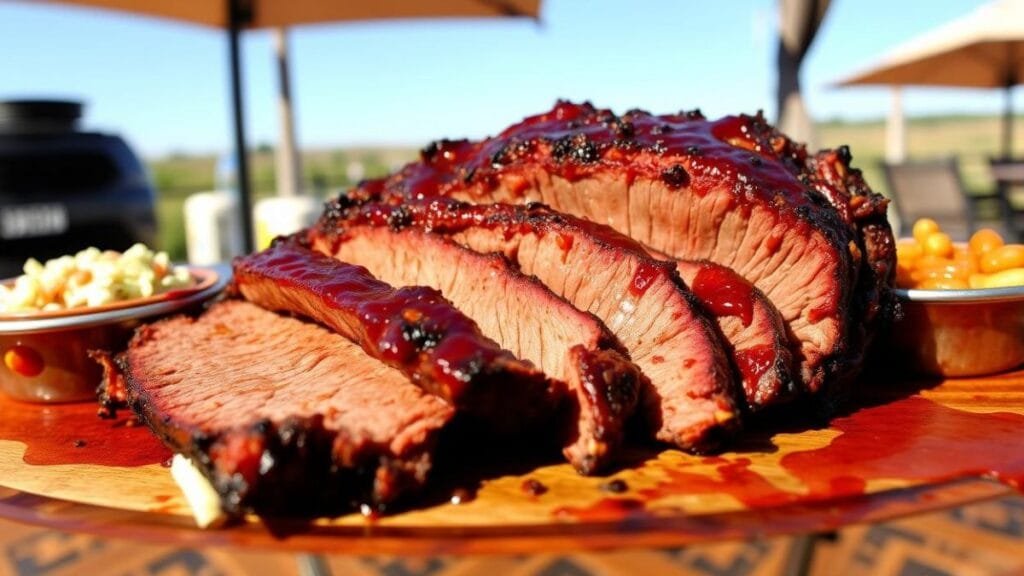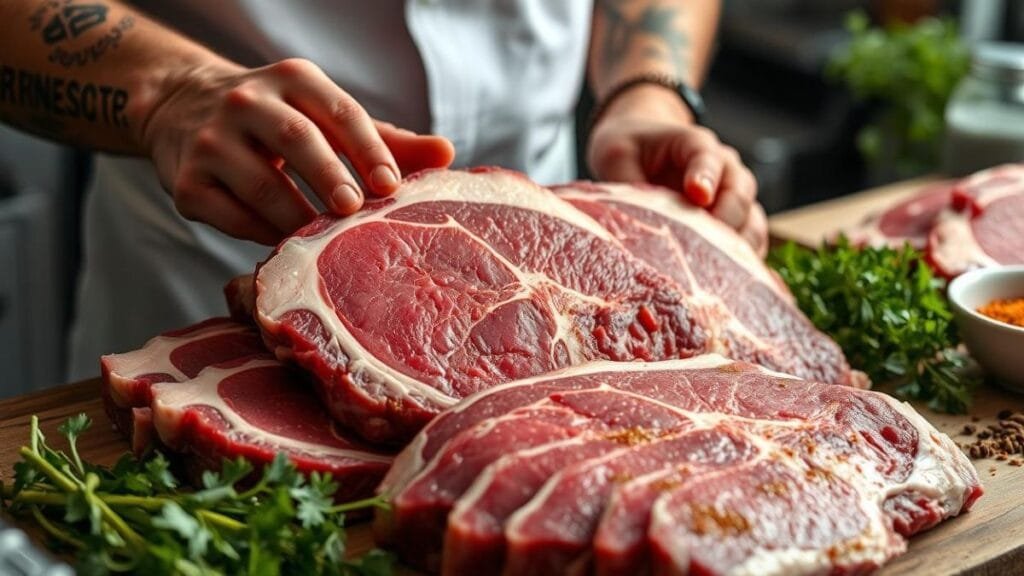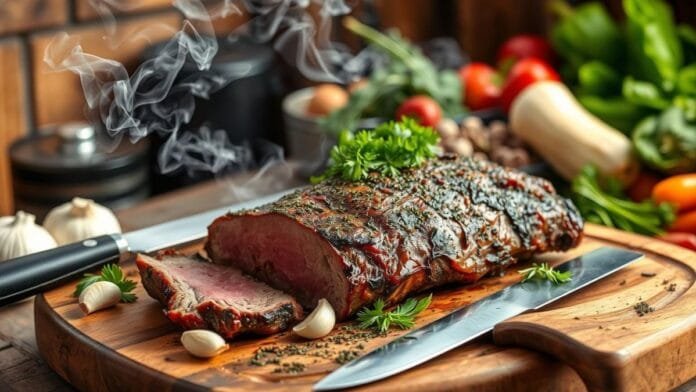Growing up in Texas, I learned that smoked brisket is more than a meal. It’s a tradition that’s part of our culture. My grandfather’s weekend barbecues always featured a delicious sliced beef brisket that made everyone’s mouth water.
Turning tough meat into tender, flavorful food is an art. It takes patience, skill, and knowing how to balance heat and time. Texas-style brisket is not just food; it’s a celebration of slow-cooking traditions passed down through generations.
Choosing the right brisket is key. A 7-8 pound cut is perfect for making a dish that feeds up to 16 people. Whether you love barbecue or want to impress at home, learning to make brisket is a culinary adventure.
Brisket’s transformation from tough meat to tender delight is amazing. It shows the power of patient cooking. Let’s explore how to make the perfect sliced beef brisket for your next meal.
Beef Brisket: From Tough Cut to Tender Delight
Brisket has a remarkable journey from a tough cut to a tender delight. It’s a favorite in beef barbecue. Its rich history and versatility have won over many food lovers.
Origin and History of Brisket
Brisket comes from the chest area of cattle. It was once seen as a tough cut. Jewish and Texas barbecue traditions helped make it tender and flavorful.
What Makes Brisket Special
Brisket is special because of its slow cooking. This process breaks down tough tissues. It turns into tender brisket sandwiches and tacos that are irresistible.
Different Parts of the Brisket
A whole brisket has two main parts:
- Point (Deckle): Fattier and more marbled section
- Flat: Leaner portion with consistent meat texture
| Brisket Grade | Marbling | Tenderness |
|---|---|---|
| Prime | High | Very Tender |
| Choice | Good | Slightly Less Tender |
| Select | Low | Can Be Tough |
Knowing these details helps both home cooks and chefs choose and prepare the best brisket for any event.
Selecting the Perfect Brisket for Your Table
Choosing the right brisket is key to making delicious smoked meat that will wow your guests. The quality of your pit-smoked beef begins with picking an outstanding cut of meat. Not all briskets are the same, and knowing what makes a great brisket can make your barbecue meats truly special.
When looking for the perfect brisket, keep these important factors in mind:
- Meat Grade: Opt for Prime or Choice grades with lots of marbling
- Weight: Go for a 10-14 pound brisket for the best slicing
- Fat Content: Choose a brisket with a fat cap about ¼ inch thick
- Meat Flexibility: Pick a fresh brisket that feels soft and pliable
Wagyu beef is the top choice for those who love pit-smoked beef. Its amazing marbling makes Wagyu briskets incredibly tender and flavorful. I suggest avoiding grass-fed beef, as it tends to be less tender.
Key Selection Criteria for Top-Quality Brisket:
- Check for consistent marbling throughout the meat
- Ensure the flat end is at least 1 inch thick
- Look for a smooth, even fat distribution
- Avoid briskets with too much hard fat or gristle
Packer briskets, which include both the flat and point sections, offer the most flexibility for smoking and slicing. By carefully choosing your brisket, you’ll lay the groundwork for a delicious barbecue experience that will have everyone wanting more.

Essential Preparation Techniques for Sliced Beef Brisket
Preparing a perfect beef brisket needs careful attention and specific techniques. These methods turn this tough cut into a delicious main dish. My method combines old ways with new ideas for the best results.
Trimming and Preparing the Meat
When working with beef brisket, being precise is important. I suggest keeping about ¼ inch of fat on top for moisture and taste. Remove the silverskin and shape the meat for even cooking. The first cut of brisket is best for its shape and fat.
- Remove excess fat carefully
- Maintain ¼ inch fat layer
- Trim silverskin for smooth texture
Seasoning Methods and Marinades
Seasoning is key for the brisket’s rich flavor. I use two main methods: a classic Texas-style rub or a complex marinade. The marinade includes:
- Soy sauce
- Worcestershire sauce
- Garlic
- Apple cider vinegar
Resting Times and Temperature Guidelines
| Cooking Parameter | Recommended Setting |
|---|---|
| Smoking Temperature | 225°F to 250°F |
| Internal Meat Temperature | 195°F to 205°F |
| Resting Time | Minimum 1 hour |
Resting the brisket lets flavors soak in and keeps it tender. Pitmasters say to rest it for at least an hour before slicing. This step keeps the meat moist and improves its taste.
Mastering the Art of Cooking Brisket
Cooking the perfect sliced brisket needs precision, patience, and skill. It’s about turning tough meat into tender, flavorful food. Knowing how to cook it is key, whether you stick to traditional recipes or try new methods.
Smoking is the top choice for cooking sliced brisket. Here’s what to keep in mind:
- Temperature range: Keep it between 225°F and 250°F for the best results
- Wood selection: Oak, hickory, and mesquite add great flavor
- Internal temperature target: Aim for 195°F to 203°F for perfect tenderness
My favorite method includes a few essential steps for a top-notch sliced beef brisket recipe:
- Start with a salt, pepper, and garlic (SPG) rub
- Wrap the brisket in pink butcher paper when it hits 160°F
- Cook it low and slow for 12-16 hours
- Let it rest for at least one hour before slicing
Other cooking methods like oven-baking and sous-vide are also good. But smoking is the best for that authentic brisket taste. Tip: Use a smoke tube or box to boost the smoky flavor.
Choosing the right equipment is as important as the technique. Get a good pellet grill or smoker with precise temperature control. The right tools can elevate your sliced brisket from good to great.
The Perfect Technique for Sliced Beef Brisket
Learning to slice beef brisket right can turn a simple meal into a memorable one. It’s all about precision and the right steps. I’ll show you how to get that perfect, tender beef brisket.
Required Tools for Proper Slicing
To slice brisket well, you need the right tools. Here’s what I suggest:
- Large cutting board with juice grooves
- Sharp carving knife (12-inch blade recommended)
- Meat fork for stabilizing
- Work gloves for safe handling
Against-the-Grain Cutting Method
Knowing the meat’s grain is key for tender slices. Brisket has two muscles: the flat and the point. Each has its own grain direction.
| Brisket Section | Characteristics | Slicing Technique |
|---|---|---|
| Flat | Leaner, more uniform muscle | Cut perpendicular to muscle fibers |
| Point | Fattier, less uniform | Identify and follow individual grain lines |
Optimal Slice Thickness
For thinly sliced beef brisket, keep your slices consistent. Aim for about 1/4 inch thick, like a pencil. This makes every bite tender and tasty.
Pro tip: Chill the brisket before slicing. It makes cutting easier and helps remove excess fat. When reheating, place the sliced brisket fat side down. This keeps it moist and flavorful.
Serving and Presentation Ideas
Serving sliced beef brisket can be a fun adventure. I’ve found many ways to make this dish stand out. It’s sure to wow your family and friends.
Here are some classic ways to serve brisket:
- Brisket sandwich with crusty bread and homemade barbecue sauce
- Brisket tacos topped with fresh cilantro and diced onions
- Plated over creamy mashed potatoes or buttery egg noodles
- Served with a zesty lemony potato salad for a bright contrast
For a family-style look, place sliced brisket on a big wooden platter. Add sautéed onions and drizzle the cooking sauce around it. This adds a rich flavor.
Tip for brisket tacos: Slice the meat against the grain for tenderness. Thin slices are perfect for warm tortillas with your favorite toppings.
Storing leftover brisket is easy. Keep it in an airtight container in the fridge for up to 3 days. It’s great for many meals during the week.
Nutritional bonus: Brisket has about 60g of protein per serving. It’s a great choice for filling meals.

Conclusion
Exploring Texas-style brisket shows us that it’s all about patience, skill, and knowledge. Sliced beef brisket is not just a meal; it’s a form of art. It turns a tough piece of meat into something tender and full of flavor.
Barbecue brisket is a showcase of slow cooking and keeping the right temperature. Knowing the lean flat and the marbled point is key. Each step, from smoking to slicing, makes for a great dining experience.
Making a top-notch sliced beef brisket is more than following a recipe. It’s about respecting the meat and paying attention to every detail. It’s about keeping the traditions of American barbecue alive. Whether you’re cooking at home or aiming to be a pitmaster, these values will make your brisket stand out.
In the end, a well-cooked brisket is more than just food. It’s a celebration of cooking that brings people together. It creates lasting memories at the dinner table.
Brisket FAQ
What is brisket and where does it come from?
Brisket comes from the lower chest of a cow. It’s known for its tough connective tissues. The term “brisket” comes from Old Norse, meaning cartilage. It gained popularity in American barbecue, thanks to German and Czech immigrants in the 19th century, mainly in Texas.
How do I choose the best brisket for cooking?
Look for brisket grades like Prime or Choice for the best flavor. A good brisket is 10-14 pounds, with a thick fat cap. It should be flexible and have good marbling for tenderness and flavor.
What are the best cooking methods for brisket?
I suggest three main methods: smoking, oven-baking, and sous-vide. Each method needs careful temperature control. This ensures the meat becomes tender and absorbs flavors well.
How do I know when my brisket is fully cooked?
Check the internal temperature. Brisket is done at 195°F to 205°F. After cooking, let it rest for at least an hour. This redistributes juices for maximum tenderness.
What’s the best way to slice brisket?
Always slice against the grain with a sharp knife. Cut perpendicular to the muscle lines for ¼-inch thick slices. Chilling the brisket slightly before slicing helps remove excess fat.
How can I serve sliced brisket?
Brisket is very versatile. Serve it over egg noodles, in sandwiches, as tacos, or with mashed potatoes. Garnish with sautéed onions or use cooking sauce as a gravy for extra flavor.
How long can I store cooked brisket?
Cooked brisket can be refrigerated for 3-4 days. Freeze it for up to 3 months for longer storage. When reheating, place slices fat side down in a pan and warm in a 350-degree oven to keep moisture.
What are the different parts of a brisket?
A brisket has two parts: the point (fattier) and the flat (leaner). The point is more marbled and flavorful. The flat is drier but delicious when cooked right.
Can I prepare brisket in advance?
Yes! Cook the brisket ahead of time, cool it completely, and then freeze or refrigerate. Reheat in a 350-degree oven when ready to serve. This helps keep moisture and flavor.
What are some good seasoning options for brisket?
Traditional seasoning is simple salt and black pepper. I also suggest marinades with soy sauce, Worcestershire, garlic, and apple cider vinegar. Let the seasonings penetrate the meat by resting it before cooking.













